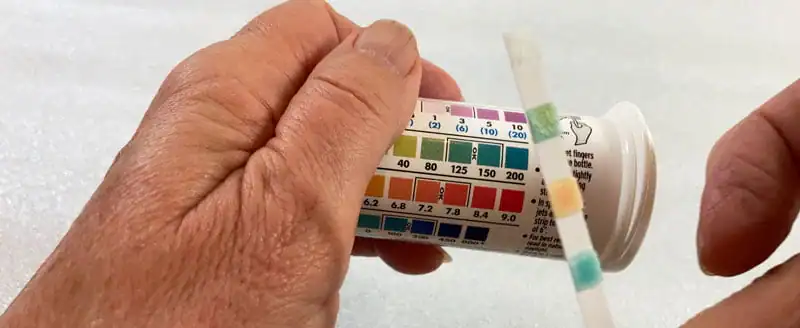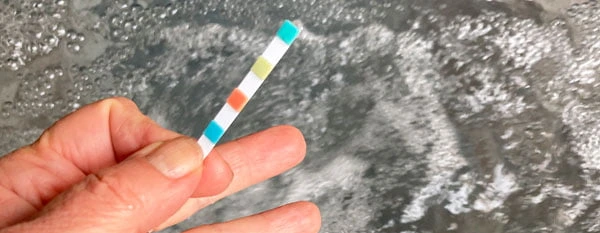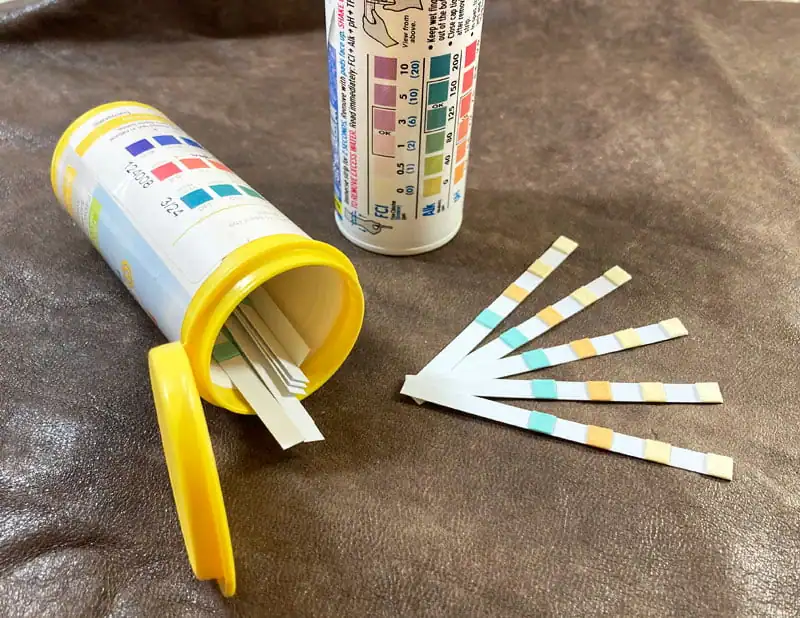Swimming pool owners know the importance of keeping their pools clean and well-maintained, and one of the critical components of pool maintenance when you use a salt chlorine generator is testing the pool’s salt levels. Salt test strips are a popular and convenient method for measuring pool salt levels, but many pool owners wonder about their accuracy.
Since the pool sanitation is dependent on having the correct salt concentration, it’s essential to understand the accuracy of pool salt test strips and what factors can affect their results. In this article, I’ll take a look at the accuracy of pool salt test strips, how they work, and what what the alternatives are for obtaining accurate readings. I’ll also discuss the importance of testing pool salt levels and what can happen if the levels are not properly maintained.
If you’re already a pool owner or considering buying a pool, read on to learn more about the accuracy of pool salt test strips and how to ensure that your pool is safe and comfortable for swimming.
Are Pool Test Strips Accurate?
Generally, pool test strips can provide an accurate reading of the salt level in a pool, but their accuracy can be affected by various factors including exposure to moisture or high temperatures. The most important factor is getting a pool test strip that is designed to read the same range values that are used in a pool that uses a salt chlorine generator for sanitation.
Saltwater pools that use salt chlorine generators, or ‘salt cells’ need to have salt water concentrations in the range of 2,700 and 3,400 parts per million (ppm), with 3,200 ppm being the optimum level. As a result, you want a test strip that is designed to read for this concentration level. There are salt test strips that are designed for other applications, such as for Koi Ponds that are designed to give their best readings for much lower salt concentration. Salt test strips made for saltwater aquariums are designed for much higher salt concentrations.
While pool test strips that are chosen for your target salt concentration levels are certainly accurate enough to know if you need to add salt or not, some people just want to see a value, instead of just knowing a range. If you are this type of person, you will probably be happier with a digital meter, despite needing to deal with batteries and calibration at times.
When water test strips are expired or not stored properly, they can also produce false readings. To ensure the accuracy of your pool salt test strips, it is recommended to store them in a cool, dry place and check their expiration date before use. Additionally, it is important to follow the manufacturer’s instructions carefully when using the strips. If you have any doubts about the accuracy of your test strips, you can also get your pool’s salt level tested by a professional.
What do Pool Test Strips Measure?
Pool test strips designed for saltwater pools measure the concentration of salt in parts per million (ppm). The ideal salt level for a saltwater pool is generally between 2,700 and 3,400 ppm, although this can vary depending on the specific type of pool and the manufacturer’s recommendations.
If the salt level in the pool is too low, the pool’s sanitizing system may not function properly, and if the salt level is too high, it can lead to corrosion and damage to the pool’s equipment.
When salt is added to a pool, it is dissolved in the water and converted into free chlorine through a process called electrolysis. The free chlorine then kills bacteria and other microorganisms in the water, keeping the pool clean and safe.

How Do Pool Test Strips Work?
To use a pool salt test strip, dip the strip into the pool and wait the manufacturer’s recommended amount of time. The strip is then removed from the water and the color change on the strip is compared to an included color chart that indicates the salt content in parts per million (ppm.)
Pool salt test strips are designed to work using a chemical reaction that takes place between the strip and the water in the pool. The strip contains a chemical indicator that changes color in the presence of salt. When the strip is dipped into the pool water, the indicator reacts with the salt in the water and produces a color change on the strip.
While water test strips can be quite effective at indicating whether your salt levels are appropriate, part of getting an accurate reading is your ability to compare the color on the test strip to the color on the side of the test strip container. Some people find this very easy to do, but some people have trouble judging colors or color tones, so this might be a factor in whether test strips are a good choice for you.
It is important to compare the colors when you have good lighting – so a very cloudy day could affect your ability to compare. Even consider that some sunglasses change the color of what you are seeing, so I make sure I look at the color comparison with my glasses on and again without the glasses.
Why It’s Important to Test Pool Salt Levels
Testing the salt levels in a swimming pool is important for several reasons. Here are a few of the key reasons why testing pool salt levels are essential for maintaining a safe and healthy swimming pool:
- Sanitization – Salt is a critical component of a saltwater pool, as it is converted into free chlorine through the process of electrolysis. Free chlorine is an important sanitizing agent that helps to kill bacteria and other microorganisms in the pool water, making it safe for swimming. If the salt level in the pool is too low, the pool’s sanitization system may not function properly, which can lead to unsanitary conditions in the pool.
- Corrosion – If the salt level in the pool is too high, it can lead to corrosion and damage to the pool’s equipment, such as the pump, filter, and heating system. This can result in costly repairs and maintenance, as well as potential safety hazards for swimmers.
- Comfort – The right salt level in the pool can also contribute to swimmers’ comfort. If the salt level is too low, the water may not feel as soft and smooth as it should. On the other hand, if the salt level is too high, it can cause skin and eye irritation, making swimming an unpleasant experience.
To guarantee the ideal swimming environment for everyone, pool owners must test their salt levels often. This is particularly critical as regular testing helps prevent any damage to your equipment and keeps your sanitizing system performing at optimal capacity. If you’d like to read more about saltwater pool maintenance, please see the article Saltwater Pools: How Much Salt For Proper Chlorination? That article also contains a Pool Salt Calculator if you are trying to figure out how much salt to add after obtaining your current salt concentration reading.

Is It Better To Use Pool Test Strips or a Digital Meter to Measure Salt Levels in a Pool?
When it comes to measuring salt levels in a pool, pool salt test strips and digital meters are the two primary options available to pool owners. While both methods are effective, there are some differences in terms of accuracy and convenience.
Pool Test Strips
Test strips for measuring water quality are simple and easy to use, as they only require a quick dip in the pool water and a comparison of the color change to a chart.
Pros:
- Cheap and easy to use
- Quick readings
- Can detect general changes in salt levels
- Many test strips offer more testing parameters than just salt, such as Alkalinity, pH, and more.
Pro or Con, depending on how you look at it:
- The concentration reading is a general range instead of an exact value
Cons:
- Not as accurate as digital meters
- A good reading depends on the users ability to compare colors
- Affected by other chemicals in the pool water
- Must be re-purchased when they get used up (each strip may only be used one time)
- Often made of plastic, so they are not recyclable
Pool water test strips are available that not only test for salt concentration, but offer several other water quality tests such as free chlorine, alkalinity, pH, calcium hardness, and more. This might be one of the major reasons that people select test strips for pool water testing: they can get an overall view of pool health from one quick test. This ‘8-in-1’ test strip is a great choice for getting speedy readings:
Easy to use pool water testing strips quickly show you the levels of pH, Chlorine, Alkalinity and more. Most importantly, these strips will tell you what your Salt level is, which most pool test strips are not designed for.
I also like these because the color change on the salt range is pretty easy to see when you are in the 2700-3400ppm range – in other words it was designed for use with salt chlorine generators.
Digital Meters
Digital Meters are highly accurate and provide a precise digital readout of the salt level in the pool. They are not as easily influenced by other chemical levels in the pool and do not require any color comparison. However, digital meters can be more expensive than test strips and may require occasional calibration.
Pros:
- Highly Accurate
- Unaffected by other chemicals in the pool water
- No color comparison required
- One time purchase
- No plastic waste
Cons:
- More expensive than test strips
- May require calibration and maintenance
One point of confusion that I should point out, Digital meters for salt tend to read in Parts Per Thousand (ppt) instead of Parts Per Million (ppm). So the range you are looking for in a saltwater pool is 2.7 to 3.4 ppt.
In the end, it all boils down to one’s personal preferences and budget when choosing between using pool salt test strips or digital meters. Test strips are a dependable yet inexpensive alternative for those who want speed and simplicity. At the time of writing this article, a digital meter costs 3x to 4x as much as a package of 120 to 150 test strips. On the other hand, if you’re seeking maximum accuracy and precision with your readings, then investing in a digital meter is likely the better option.
Regardless of the method chosen, regular testing of the pool’s salt levels is essential to maintaining a safe and comfortable swimming experience for all.
How Can You Tell If Your Pool Salt Test Strips Are Producing Accurate Results
Pool salt test strips that are still packaged, not expired, and stored inside away from the elements should provide accurate readings. If it has been a while since you’ve last measured or are unsure of the results, use multiple strips to take different readings and compare.
First, it’s important to make sure that the pool salt test strips are not expired or damaged. Old or improperly stored test strips can lead to inaccurate readings, so it’s essential to check the expiration date and storage conditions of the strips. If the test strips are expired or damaged, they should be replaced with a fresh batch.
It’s also important to follow the instructions on the test strips carefully, including the recommended test time and water depth. I’ve had strips that wanted 1 second of exposure time and others that wanted at least 3 seconds. Some test strips want a bit of time to process the reading – the color on the strip develops after 15 to 30 seconds. I’ve always found that the instructions on the package are pretty good at letting you know if you need to do more than just a quick swish and immediate reading.
Finally, if pool owners are still unsure about the accuracy of their test strips, they can use a secondary testing method to verify the results. This could include using a digital meter or taking a water sample to a pool supply store for testing. This will provide an additional level of verification and ensure that the pool’s salt levels are accurately measured.

Frequently Asked Questions
How Do You Calibrate Pool Salt Test Strips?
Pool salt test strips do not require calibration, as they are pre-treated with the necessary reagents to measure the salt content in a pool. However, it is important to ensure that the test strips are properly stored to maintain their accuracy. Improper storage or exposure to moisture, heat, or light can affect the accuracy of the strips, so it’s essential to keep them in a dry, cool, and dark place until ready to use.
Additionally, pool salt test strips have a finite shelf life, and it’s important to check the expiration date before using them. If the strips are expired or damaged, they should be replaced with a fresh batch to ensure accurate readings.
How Often Should You Test Pool Salt Levels?
In general, it’s recommended to test the pool’s salt levels at least once a week during the swimming season however, if the pool is heavily used or there are significant changes in the weather or other chemical levels, more frequent testing may be necessary.
Additionally, it’s a good idea to test the pool’s salt levels after any significant changes to the pool’s chemistry, such as adding salt, shocking the pool, or adding new pool water. If your free chlorine reading is trending lower, another factor to consider is the salt chlorine generator cell. Get more information about maintenance and replacement of cells at Saltwater Pool Salt Cell Need Replacing? Here’s How To Tell. Consistent checking of the salt levels in your pool will ensure that it not only remains safe for swimmers but also provides a comfortable and enjoyable swimming experience.
How Do You Adjust Pool Salt Levels?
If you’d like to raise the levels of salt in your swimming pool, simply add some pool-grade salt directly into the water. The precise amount that’s needed will depend on how large the swimming area is and what kind of salinity it already has. To lower the salt level, you can use a pool flushing agent, which will gradually lower the levels of salt in your pool, or partially drain and refill it with fresh water.
We provide a handy pool salt calculator in this article: Saltwater Pools: How Much Salt For Proper Chlorination?
What if the Test Strip Color and the Color Chart Don’t Match?
There can be a number of reasons that the test strip can be hard to read. Some suggestions:
– Compare the test strip and the color chart out-of-doors; try looking at them in the sun and also in the shade. You can also try looking at them indoors in a bright location.
– Remember that you are not looking for an exact color match, but trying to fit the color on the wet test strip between two adjacent colors on the chart.
– Some test strip brands just have lousy charts, or lousy material on the strips: be sure to try other brands to find those that work best for you.
– Some people who have color blindness may have difficulty comparing colors. If you don’t have a family member or neighbor that can help you with the color tones, digital meters or even liquid reagent test kits may be a better choice for you.
How do Pool Water test strips Work?
Water test strips have small pieces of material (pads) that are coated with chemicals that react with specific substances in the water. When dipped into water, the pads change color based on the concentration of compounds in the water.
How long do you dip the pool water test strip in water?
The length of time to submerge the strip usually is between 1 and 5 seconds, but be sure to look at the instructions that come with your test strips so that you will get an accurate reading. Also, I like to have the circulation pumps running when I do my testing so that I get the most accurate reading.
How long do you wait before reading the water testing results?
You will usually get accurate readings within 10 seconds to 1 minute, but the optimum length of time for your brand of test strips will be listed on the container. Tests like pH can be very quick, but some of the other readings such as Alkalinity should be read close to the suggested length of time for the strips you are using.
Can I use the same strip for multiple tests?
Nope! Test strips are designed to be used one time. Once they get wet, they are done. Fortunately, pool water test strips are pretty affordable and you tend to get a bunch of them in a package.
Are pool water test strips recyclable?
Nope! Virtually all of them seem to be made from plastic with paper/fiber pads glued onto them. The type of plastic is not marked, and recycling things made from multiple materials is difficult.
If anyone has a source for eco-friendly all paper test strips, please let me know!
Table of Contents
Pool water photo by Maria Fernanda Pissioli.








